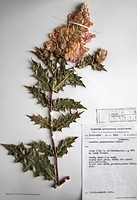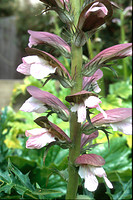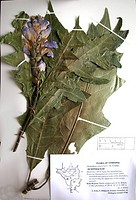Acanthus Clade
Lucinda A. McDade and Carrie Kiel- Acanthus eminens C. B. Clarke
- Acanthus ilicifolius L.
- Acanthus longifolius Host.
- Acanthus mollis L.
- Acanthus montanus (Nees) T. Anders.
- Acanthus pubescens (Oliver) Engler
- Acanthus sennii Chiovenda
- Acanthus spinosus L.
- Blepharis dhofarensis A. G. Miller
Note: this taxon list is still under construction. It does not yet contain all known Acanthus Clade subgroups.
The list above includes only taxa that were sampled by McDade et al. (2005). There are other species of Acanthus that likely belong to this clade but this needs to be confirmed with further study.
Introduction
Acanthus L. is an Old World genus of about 20 species; most species occur in Africa but a few range into southern Europe and one extends through south Asia and Malesia to Australasia. Studies to date indicate that the genus is monophyletic with the inclusion of a single species of Blepharis (see below). Excepting this single Blepharis, Acanthus is apparently unique among members of the one-lipped clade (i.e., Crossandra through Acanthus clade in the phylogeny for Acantheae) in having glabrous or rarely puberulous seeds.
These are, to our knowledge, the only architecturally important members of Acanthaceae. Acanthus leaves have a long history of use as a decorative motif in architecture of the Meditteranean area (for examples: Acanthus Gallery). A number of species of Acanthus are also widely cultivated, in particular A. mollis.
Perhaps the most unusual species of the genus is A. ilicifolius, the “mangrove thistle.” This plant shares many of the peculiar adaptations that characterize mangroves (e.g., special glands to secrete salt, special roots that emerge above the water surface to permit gas exchange even during high tide; see Tomlinson 1986). It occurs in coastal habitats from south Asia to Australia. In this context, it is interesting that the mangrove genus Avicennia has been shown to be part of Acanthaceae s.l.: phylogenetic results indicate that Avicennia and A. ilicifolius are not closely related such that the mangrove habit has evolved twice in acanths.
We refer to this group as the Acanthus clade rather than simply Acanthus because, as noted above, it includes one species of Blepharis, B. dhofarensis. Inclusion of this species with Acanthus is both very strongly supported by our molecular data (see McDade et al. 2005) and also unexpected based on morphology. To verify our results, we obtained DNA from a different specimen of this species and obtained essentially identical DNA sequence data for it, which enabled us to rule out contamination. Vollesen (2000) has noted that this species is remarkable in Blepharis in a number of characters including habit, and size of the anthers, capsules, and seeds. However, these plants have a number of the synapomorphies of Blepharis, notably dimorphic filaments and hygroscopic trichomes on seeds. This enigmatic result deserves further study.
References
McDade, L. A., T. F. Daniel, C. A. Kiel, and K. Vollesen. 2005. Phylogenetic relatinships among Acantheae (Acanthaceae): Major lineages present contrasting patterns of molecular evolution and morphological differentiation. Systematic Botany 30: 834-862.
Tomlinson, P. B. 1986. The botany of mangroves. Cambridge: Cambridge University Press.
Vollesen, K. 2000. Blepharis (Acanthaceae): a taxonomic revision. Kew: Royal Botanic Gardens.
Title Illustrations

About This Page

Rancho Santa Ana Botanic Garden, Claremont, California, USA
Carrie Kiel

Rancho Santa Ana Botanic Garden
Correspondence regarding this page should be directed to Lucinda A. McDade at and Carrie Kiel at
Page copyright © 2006 and Carrie Kiel
All Rights Reserved.
- First online 12 September 2006
- Content changed 12 September 2006
Citing this page:
McDade, Lucinda A. and Carrie Kiel. 2006. Acanthus Clade. Version 12 September 2006 (under construction). http://tolweb.org/Acanthus_Clade/52304/2006.09.12 in The Tree of Life Web Project, http://tolweb.org/












 Go to quick links
Go to quick search
Go to navigation for this section of the ToL site
Go to detailed links for the ToL site
Go to quick links
Go to quick search
Go to navigation for this section of the ToL site
Go to detailed links for the ToL site